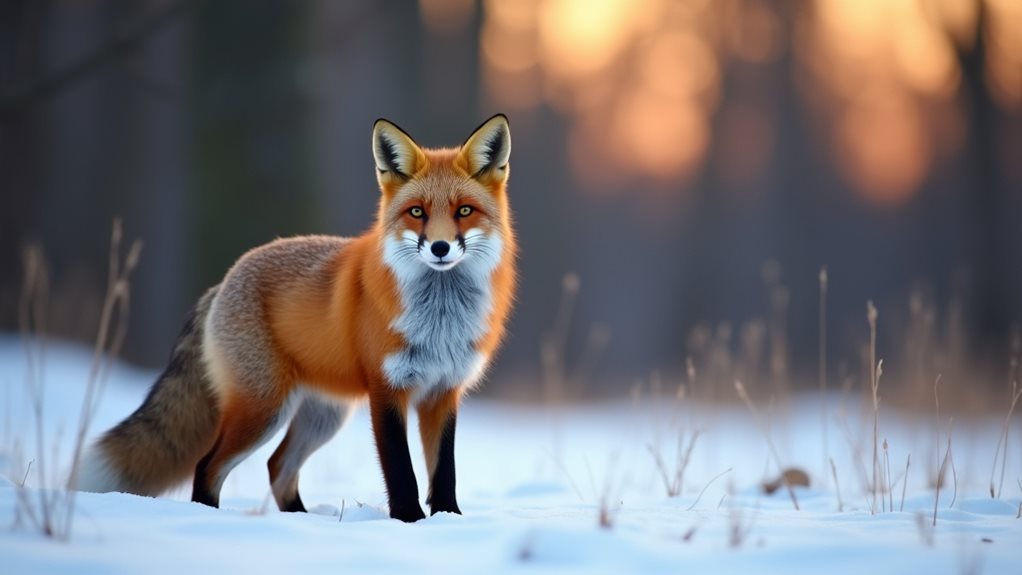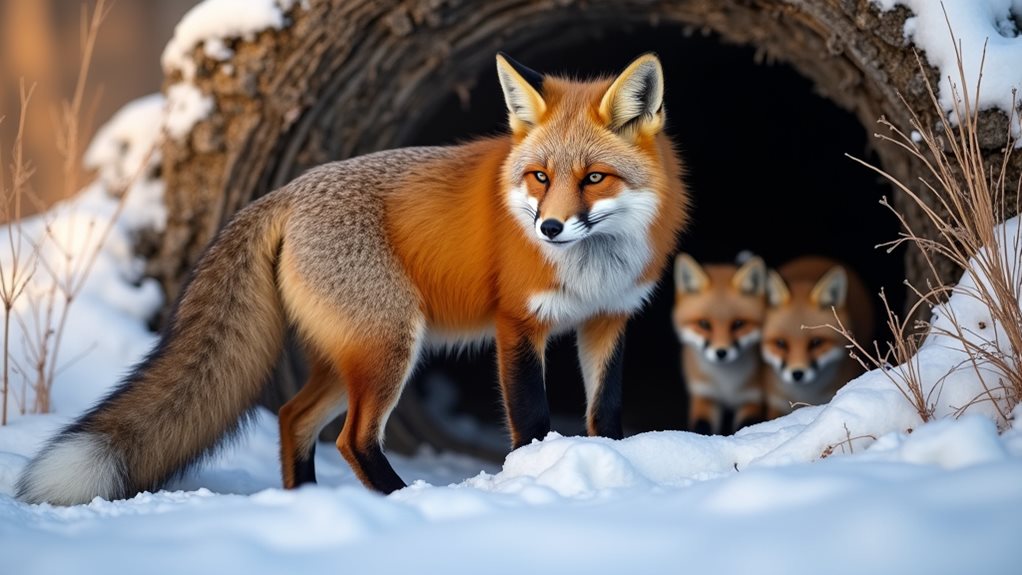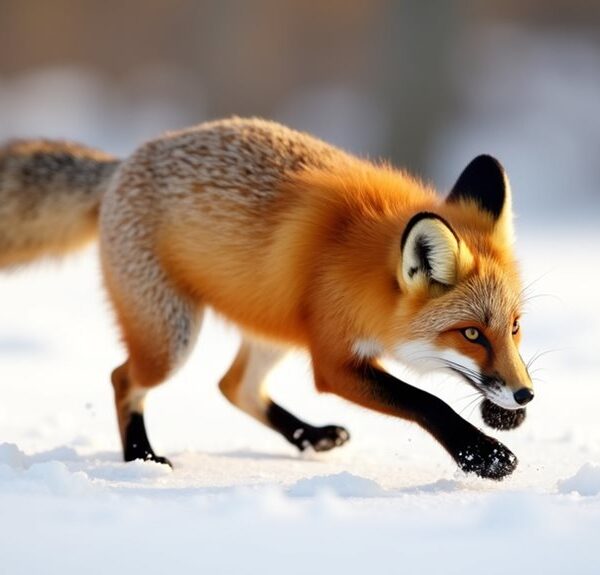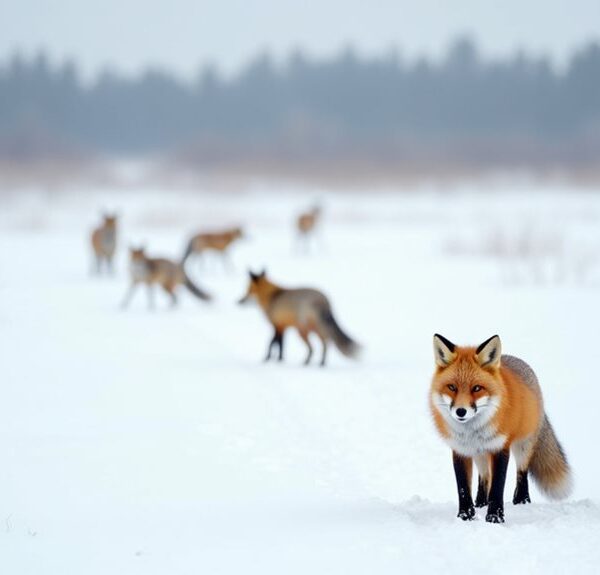Foxes master adaptation through an impressive toolkit of survival skills. You’ll find they adjust their diets seasonally, develop specialized physical traits like the Arctic fox’s thick fur or the fennec’s heat-dispersing ears, and show remarkable problem-solving abilities in urban environments. They’re flexible with their social structures and reproductive timing, shifting family dynamics based on available resources. Their intelligence shines when they create innovative hunting strategies and maneuver through human environments with surprising ease. These clever creatures have more survival secrets than meets the eye.
Contents
- 1 The Evolutionary Journey of Fox Species Across Global Habitats
- 2 Physiological Adaptations: From Arctic Insulation to Desert Survival
- 3 Dietary Flexibility: How Foxes Adjust Their Menu to Available Resources
- 4 Urban Fox Intelligence: Problem-Solving in Human Landscapes
- 5 Social Structure Shifts: Family Dynamics in Changing Environments
- 6 Reproductive Strategies: Breeding Adaptations to Environmental Pressures
- 7 Final Thoughts
The Evolutionary Journey of Fox Species Across Global Habitats

While most creatures struggle to adapt to new environments, foxes have proven themselves masters of evolutionary flexibility across the globe.
You’ll find these clever canids thriving from Arctic tundras to scorching deserts, showcasing remarkable habitat diversity that few mammals can match.
What’s their secret? It’s all about behavioral flexibility!
You’ve probably noticed foxes adjusting their diets seasonally—they’ll happily munch on berries in summer, then switch to hunting rodents when winter arrives.
They’re not picky eaters!
Their adaptable nature extends to their living arrangements too.
Unlike specialized animals that can’t survive environmental changes, foxes quickly adjust their dens, hunting patterns, and social structures to fit local conditions. This impressive versatility allows them to thrive in both rural and urban environments.
It’s this impressive versatility that’s allowed fox species to colonize six continents while maintaining their signature cunning charm.
Physiological Adaptations: From Arctic Insulation to Desert Survival
When you examine a fox’s body closely, you’ll discover it’s a marvel of evolutionary engineering designed for survival in extreme conditions.
These clever creatures have developed remarkable physiological adaptations that let them thrive from the frozen Arctic to scorching deserts.
Arctic foxes showcase incredible fur insulation, growing extra-thick coats that trap warm air next to their skin. Their compact bodies, short ears, and furry paws all contribute to heat retention in frigid environments.
Meanwhile, desert foxes like the fennec sport oversized ears that act as natural air conditioners, dispersing body heat efficiently.
You’d be amazed at how foxes regulate their metabolism seasonally, conserving energy when food is scarce. Their specialized paw pads even protect against harsh terrain, whether it’s burning sand or freezing ice.
Arctic foxes also exhibit behavioral adaptations like creating dens that provide shelter from extreme weather, showcasing their cleverness in surviving harsh conditions.
Nature has truly equipped these adaptable animals for almost any challenge!
Dietary Flexibility: How Foxes Adjust Their Menu to Available Resources

You’ll be amazed at how foxes shift their eating habits with whatever nature provides, from hunting small mammals in winter to feasting on berries and insects during warmer months.
Their opportunistic feeding strategies allow them to thrive in diverse environments, whether they’re snatching eggs from ground-nesting birds or scavenging human leftovers near urban areas.
This remarkable dietary flexibility explains why you’ll find these clever canids surviving in environments ranging from frozen tundra to scorching deserts, adapting their menu to match seasonal availability. Notably, the balance of their diet shifts from small mammals in spring to greater reliance on fruits and scavenging in autumn and winter.
Opportunistic Feeding Strategies
Foxes have earned their reputation as nature’s ultimate food opportunists through their remarkable dietary flexibility.
You’ll often find these clever creatures adjusting their hunting patterns to minimize predator avoidance while maximizing their chances of success. They’ll hunt during dawn or dusk when competition is lower but prey is still active.
When food is plentiful, foxes employ food caching—storing excess meals by burying them for later consumption. This smart strategy helps them prepare for leaner times.
You might be surprised to learn that a single fox can create dozens of these natural “refrigerators” throughout its territory!
Their opportunistic approach means they’re equally comfortable hunting rodents, scavenging carcasses, or raiding your garden for fruits and vegetables—whatever guarantees their survival in changing environments. Urban foxes, in particular, have adapted to thrive on human food scraps, showcasing their incredible resourcefulness.
Seasonal Diet Shifts
Throughout the changing seasons, nature’s ultimate opportunists demonstrate remarkable dietary adaptability that guarantees their year-round survival.
You’ll notice foxes don’t stick to a single menu—they’re constantly adjusting their food preferences based on what’s actually available.
In spring, they’ll enthusiastically hunt small rodents emerging from winter hiding, while summer brings abundant berries and insects to their diet.
When autumn arrives, you’ll find them gorging on fallen fruits and nuts, storing fat reserves for leaner times ahead.
During winter’s harsh grip, they’ll rely on cached food and whatever prey they can find beneath the snow.
This flexible approach to seasonal preferences isn’t just clever—it’s crucial, as red foxes often adjust their diet based on the availability of small mammals in their environment.
Urban Fox Intelligence: Problem-Solving in Human Landscapes
You’ll be amazed by how urban foxes demonstrate remarkable intelligence when maneuvering human environments. They’ve mastered clever tactics to access garbage bins, learned sophisticated methods to enter homes when seeking shelter or food, and developed impressive traffic maneuvering skills that help them survive busy city streets. Their problem-solving abilities show how these adaptable creatures have turned our concrete jungles into their own successful hunting grounds. Additionally, their dietary flexibility allows them to thrive on a diverse range of food sources found in urban areas.
Garbage Bin Tactics
Three distinct strategies reveal the remarkable problem-solving abilities urban foxes employ when tackling garbage bins.
You’ll notice these clever creatures first attempt the “tip and spill” technique, where they’ll rock containers until they topple over, making garbage scavenging effortless.
If that fails, they’ll try the “teamwork approach”—one fox might distract a homeowner while another raids the exposed bin.
Perhaps most impressive is their “learning curve” strategy. After watching you secure lids with bungee cords or bricks, these adaptable animals develop counter-techniques! They’ll push bins against walls to create leverage or squeeze through impossibly small openings.
Interestingly, this behavioral flexibility is a hallmark of their adaptation strategies, showcasing their resilience in urban environments.
Their urban foraging skills evolve constantly, proving these mammals aren’t solely opportunistic—they’re strategic thinkers.
Next time your trash is scattered across the yard, you’re witnessing not solely mischief, but remarkable adaptation in action.
Home Entry Methods
Urban foxes display astonishing creativity when seeking entry into human homes, despite our best efforts to keep them out. Their den entry techniques have evolved alongside our security measures, revealing their remarkable adaptability.
You’ll notice their nocturnal behaviors shift as they learn your household patterns.
These clever creatures typically gain access through:
- Exploiting pet doors, squeezing through openings as small as 6 inches wide
- Patiently digging beneath doorframes or foundations, creating subtle entry points
- Climbing nearby trees or structures to access second-story windows or balconies
- Learning to manipulate simple latches and handles with their dexterous paws
You might admire their persistence, but remember—a fox in your kitchen isn’t just a cute visitor.
They’re simply following natural instincts, seeking warmth, shelter, and potential food sources. Their role in controlling urban rodent populations also emphasizes their importance in city ecosystems.
While foxes demonstrate remarkable skill at entering our homes, their maneuvering of busy streets reveals even more impressive cognitive abilities. You’d be amazed at how these clever creatures have learned to read traffic patterns almost as well as humans. They’ll wait patiently at curbs, watching for breaks in vehicle flow before darting across safely.
What’s truly fascinating is how foxes navigate urban obstacles with calculated precision. They’ve developed mental maps of their territories, remembering dangerous intersections and finding alternative routes.
You’ll often spot them using pedestrian bridges or culverts to avoid busy roads altogether. They’ve even been observed following pedestrians across crosswalks, seemingly understanding that drivers stop for humans. This adaptive intelligence helps foxes thrive in our concrete jungles, turning potential dangers into manageable challenges, as around 70% of urban foxes successfully adjust to life in cities.
Social Structure Shifts: Family Dynamics in Changing Environments
As environments change around them, fox families demonstrate remarkable flexibility in their social structures.
You’ll notice that both family roles and social hierarchies adapt quickly when foxes face new challenges. Their resilience is truly impressive!
When environments shift, foxes adjust their family dynamics in several ways:
- Parents may share hunting duties more equally in resource-scarce areas.
- Extended family groups might form in urban settings for better protection.
- Cubs often learn different survival skills based on their specific surroundings.
- Dominance patterns can flatten when traditional territories are disrupted.
You can observe these adaptations especially during seasons of change, when fox families reorganize their priorities. Additionally, their strong social bonds with family members play a crucial role in enhancing cooperation, allowing them to thrive even in challenging circumstances.
This flexibility is why they’ve thrived across such diverse terrains—they’re masters at rewriting their social rules when needed.
Reproductive Strategies: Breeding Adaptations to Environmental Pressures

The remarkable adaptability of fox families extends beyond their social structures into their reproductive habits. You’ll find their breeding behavior shifts dramatically in response to local pressures, with urban foxes often producing larger litters than their rural counterparts when food is abundant.
Their reproductive timing is equally flexible. In colder regions, you’ll notice foxes mate during winter months, guaranteeing spring births when prey is plentiful. Meanwhile, desert fox species time their breeding to coincide with seasonal rains. This clever scheduling isn’t random—it’s a calculated response to environmental cues that maximize kit survival rates.
What’s fascinating is how quickly these reproductive strategies can evolve. A fox population facing new challenges might adjust its breeding patterns within just a few generations, showcasing nature’s impressive ability to fine-tune life’s most vital functions.
Final Thoughts
You’ve just witnessed nature’s ultimate survivors in action. While you’re busy upgrading your smartphone, foxes are casually redesigning their entire biology to thrive in your backyard. They’ll eat anything, live anywhere, and probably file your taxes if you’d only ask. Next time you’re struggling with life’s changes, remember: you don’t need to reinvent the wheel—just channel your inner fox and adapt like nobody’s watching.














